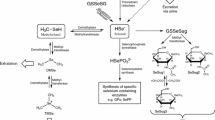Abstract
Subcutaneous administration of bismuth, both single and multiple, resulted in deposition of this metal mainly in the kidneys which contained over 50% of the ‘accessible pool’ of bismuth. In the kidneys bismuth was bound mainly by the soluble fraction in which it was complexed with a protein of molecular weight of about 7000. Multiple administration of bismuth increased the level of this protein. Selenite administration brought about an increase in the ‘accessible pool’ of bismuth, probably due to a drop in excretion, and also changes in the organ distribution of this metal. The retention in the kidneys was diminished while those in the liver and in other tissues were augmented. These changes were accompanied by a change in the chemical form of bismuth present in the kidneys manifested by the total disappearance of the protein complex of molecular weight of 7000. The increased synthesis of this protein due to bismuth administration was not abolished completely.
Zusammenfassung
Nach einmaliger und wiederholter subkutaner Verabreichung wurde Wismut zu mehr als 50% der „erreichbaren Menge” in den Nieren gefunden. Es war dort vorwiegend in der löslichen Frakion und in großem Umfang an einen Eiweißstoff vom Molekulargewicht 7000 gebunden. Bei wiederholter erabreichung von Wismut wurde auch dieser Eiweißstoff vermehrt gefunden. Die gleichzeitige Verabreichung von Selen erhöhte die „verfügbare Menge” von Wismut, wahrscheinlich wegen eingeschränkter Ausscheidung. Zugleich wurden Unterschiede in der Organverteilung von Wismut festgestellt. Der Anteil in den Nieren wirde geringer und derjenige in Leber und sonstigen. Organen größer. Der Eiweißkomplex mit dem Molekulargewicht 7000 verschwand gänzlich. Die durch Wismut stimulierte Synthese dieses Eiweißstoffes wirde aber nicht ganz verhindert.
Similar content being viewed by others
References
Chen, R. W., Whanger, P. D., Fang, S. C.: Diversion of mercury binding in rat tissues by selenium: a possible mechanism of protection. Pharmacol. Res. Commun.6, 571 (1974)
Chen, R. W., Whanger, P. D., Weswig, P. H.: Selenium-induced redistribution of cadmium binding to tissue proteins: a possible mechanism of protection against cadmium toxicity. Bioinorganic Chemistry4, 125–133 (1975)
Kägi, J. H. R., Vallee, B. L.: Metallothinein: a cadmium and zinc-containing protein from equine renal cortex. J. biol. Chem.236, 2435–2442 (1961)
Komsta-Szumska, E, Chmielnicka, J.: Binding of mercury and selenium in subcellular fractions of rat liver and kidneys following separate and joint administration. Arch. Toxicol.38, 217–228 (1977)
Komsta-Szumska, E., Chmielnicka J., Piotrowski, J. K.: The influence of selenium on binding of inorganic mercury by metallothionein in the kidney and liver of the rats. Biochem. Pharmacol.25, 2539–2540 (1976)
Moffitt, A. E., Clary, J. J.: Selenite-induced binding of inorganic mercury in blood and other tissues in the rat. Res. Commun. Chem. Path. Pharm.7, 593–603 (1974)
Norseth, T., Brendeford, M.: Intracellular distribution of inorganic and organic mercury in rat liver after exposure to methylmercury salts. Biochem. Pharmacol.20, 1101–1107 (1971)
Parizek, J., Kalouskova, J., Babicky, A., Benes, J., Pavlik, L.: Interaction of selenium with mercury, cadmium and other toxic metals. In: Trace element metabolism in animals. (H. G. Hoekstra, J. W. Suttie, H. E. Ganther, W. Mertz, eds.) Vol. 2, p. 119. Baltimore: University Park Press 1974
Piotrowski, J. K., Bolanowska, W., Sapota, A.: Evaluation of metallothionein content in animal tissues. Acta biochim. pol.20, 207–215 (1973)
Piotrowski, J. K., Trojanowska, B., Sapota, A.: Binding of cadmium and mercury by metallothionein in the kidneys and liver of rats following repeated administration. Arch. Toxicol.32, 351–360 (1974a)
Piotrowski, J. K., Trojanowska, B., Wiśniewska-Knypl, J. M., Bolanowska, W.: Mercury binding in the kidney and liver of rats repeatedly exposed to mercuric chloride: induction of metallothionein by mercury and cadmium. Toxicol. appl. Pharmacol.27, 11–19 (1974b)
Piotrowski, J. K., Szymańska, J. A.: Influence of certain metals on the level of metallothionein-like proteins in the liver and kidneys of rats. J. Toxicol. Environ. Hlth.1, 991–1002 (1976)
Russ, G. A., Bigler, E. R., Tilbury, R. S., Woodward, H. Q., Laughlin, J. S.: Metabolic studies with radiobismuth. I. Retention and distribution206Bi in normal rat. Radiat. Res.63, 443–454 (1975)
Szymańska, J. A., Mogilnicka, E. M., Kaszper, B. W.: Binding of bismuth in the kidneys of the rat: The role of metallothionein-like proteins. Biochem. Pharmacol.26, 257–258 (1977)
Żelazowski, A. J., Piotrowski, J. K.: A modified procedure for the determination of metallothionein-like proteins in animal tissues Acta biochim. pol.24, 97–103 (1977)
Author information
Authors and Affiliations
Rights and permissions
About this article
Cite this article
Szymańska, J.A., Zychowicz, M., Zelazowski, A.J. et al. Effect of selenium on the organ distribution and binding of bismuth in rat tissues. Arch Toxicol 40, 131–141 (1978). https://doi.org/10.1007/BF01891968
Issue Date:
DOI: https://doi.org/10.1007/BF01891968




